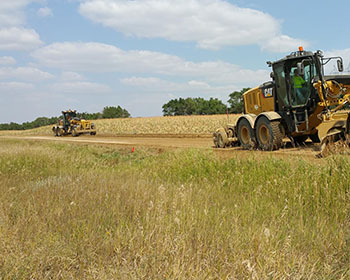North Dakota Township Officers Association - Gravel Roads
Gravel Roads
NDLTAP
Gravel / Motor Grader Resources
Gravel Road Surfacing
The North Dakota DOT maintains only PAVED ROADS. As such, the DOT uses gravel for pavement base and
shoulder material. They typically specify:
Cl 5 Gravel - drainable base material that is placed beneath a paved surface. Water that passes
through pavement cracks enters the Cl 5 base. Since the Cl 5 base has limited fine material, water
easily drains to the outer edge of the roadway rather than progressing down into the subgrade. By
keeping the subgrade (i.e., natural soil foundation) dry, the NDDOT maximizes the roadway's load-carrying capacity.
Cl 13 Gravel - shouldering material for highways. Cl 13 shoulder material is essentially a Cl 5
material with more fine material allowed (i.e., a dirty Cl 5). The fine material provides a
reduction in water passage and allows sensible utilization of pit materials.
Local roadway gravel surfacing requires modifications to the typical pavement base and shouldering
gravel. Gravel without binder leads to wash boarding, dust, and float - all critical safety risks.
Adding a binder can create a quality gravel surfacing material for local gravel roads.
Quality gravel surfacing includes a binder material to hold the stone and sand together. Clay is a
natural binder that can bind the stone and sand into a gravel matrix. Generally, fines may be clay
or silt. Clay has good binder properties, silt does not. Clay has good engineering strength
properties, silt does not. A gradation test tells us the amount of rock, sand, and fines. A Pl test
(Plasticity Index - clay value) - this tells us how cohesive or 'sticky' the fine material is and
, as such, how well it will perform to hold the rock and sand together. Combined, the tests help tell
us how well the gravel will function as a surfacing material. See the spec info below.
Specifying and testing gravel are key to ensuring that you get the correct gravel for your gravel
road driving surface.
February 1, 2018
Dale C. Heglund, PE/PLS, NDLTAP Program Director -701-318-6893, dale.heglund@ndsu.edu
 Roadway design, gravel quality and motor grader operation are key factors for maintaining gravel roadways. This section is a one-stop shop for gravel roadway information, providing gravel roadway training and technology ranging from resource publications to hands-on motor grader field training. With more than 50% of North Dakota's 106,000 mile roadway network relying on gravel surfacing it is imperative that gravel roadway technologies be shared and that technology advancements be an integral part of the state's asset management plan.
Roadway design, gravel quality and motor grader operation are key factors for maintaining gravel roadways. This section is a one-stop shop for gravel roadway information, providing gravel roadway training and technology ranging from resource publications to hands-on motor grader field training. With more than 50% of North Dakota's 106,000 mile roadway network relying on gravel surfacing it is imperative that gravel roadway technologies be shared and that technology advancements be an integral part of the state's asset management plan.
Unpaved Road Chemical Treatment Selection Tool
Low-Cost Safety Improvements for Unpaved Roads
Gravel Surfacing Spec (PDF, 99K)
2021 Motor-Grader Operator Training (PDF, 1088K)
Motor-Grader Operator Training Introduction
Gravel Road Maintenance: Meeting the Challenge
Meeting the Mark on Gravel Quality Webinar Recording
- Meeting the Mark on Gravel Quality Presentation Slides (PDF, 9.57 MB)
- One Page Guides and References for 2020 NDLTAP Classes (PDF, 4350K)
- Exploration, Development, and Reclamation of Aggregate Resources (PDF, 38.1 MB)
Gravel Surfacing and Calcium Chloride Stabilization Project ROM-0300(142)
- Webinar Recording - Part 1
- Webinar Recording - Part 2
- Webinar Presentation (PDF, 3006K)
- NDDOT Request for Proposal (PDF, 2747K)
- NDDOT Scope of Work (PDF, 11.8 MB)
Gravel Spread Chart (PDF, 907K)
Slope Meter (PDF, 1898K)
Gravel Road Management Tool, Minnesota LRRB
Oxy Study - Calcium Chloride vs Magnesium Chloride (PDF, 247K)
Dust Suppressant, DustGard (PDF, 1363K)
Local Road Surface Selection Tool
Guidelines for the Selection, Specification and Application of Chemical Dust Control and Stabilization Treatments on Unpaved Roads (PDF, 28.3 MB)
Quality Gravel's Secret Ingredient is Clay
Grader Mount Sod Mulcher (PDF, 764K)
Gravel Reclaimer (PDF, 844K)
A Day in the Life of a Blade Operator (PDF, 108K)
Gravel Roads Presentation, ASHE - Central Dakota Section
Gravel Roads Presentation, Sargent County Township Meeting
Gravel Roads: Construction and Maintenance Guide, FHWA (PDF, 17.8 MB)
Motor-Grader Maintenance Presentation (PDF, 3549K)
Answers to Common Questions About Gravel Roads, Minnesota LRRB
Aggregate Roads Dust Control: A Brief Synthesis of Current Practices
Unpaved Road Dust Management: A Successful Practitioner's Handbook (PDF, 5897K)
Smoothing and Reshaping the Traveled Way
Preliminary Analysis of Dust Control Measures (PDF, 181K)
Dust Control Information (PDF, 177K)
Gravel Roads Part II: Back to the Basics, Montana LTAP (PDF, 4786K)
